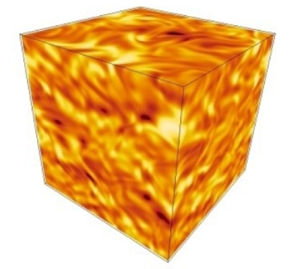Article contents
Waves and non-propagating modes in stratified MHD turbulence subject to a weak mean magnetic field
Published online by Cambridge University Press: 11 December 2024
Abstract

In this study we consider a freely decaying, stably stratified homogeneous magnetohydrodynamic turbulent plasma with a weak vertical background magnetic field ( $\boldsymbol {B}_0=B_0\hat {\boldsymbol {z}}),$ aligned with the density gradient of strength
$\boldsymbol {B}_0=B_0\hat {\boldsymbol {z}}),$ aligned with the density gradient of strength  $N$ (i.e. Brunt–Väisälä frequency). Both linear theory and direct numerical simulations (DNS) are used to analyse the flow dynamics for a Boussinesq fluid with unitary magnetic and thermal Prandtl numbers. We implemented a normal mode decomposition emphasizing different types of motions depending on whether both the Froude
$N$ (i.e. Brunt–Väisälä frequency). Both linear theory and direct numerical simulations (DNS) are used to analyse the flow dynamics for a Boussinesq fluid with unitary magnetic and thermal Prandtl numbers. We implemented a normal mode decomposition emphasizing different types of motions depending on whether both the Froude  $F_r$ and Alfvén–Mach
$F_r$ and Alfvén–Mach  $M$ numbers are small or only
$M$ numbers are small or only  $F_r$ is small but
$F_r$ is small but  $M$ is finite. In the former case, there is a non-propagating (NP) mode and fast modes: Alfvén waves with frequency
$M$ is finite. In the former case, there is a non-propagating (NP) mode and fast modes: Alfvén waves with frequency  $\omega _a$ and magnetogravity waves with frequency
$\omega _a$ and magnetogravity waves with frequency  $\omega _{ag}$. In the latter case, there are fast gravity waves with frequency
$\omega _{ag}$. In the latter case, there are fast gravity waves with frequency  $\omega _g$ and slow modes: NP mode and slow Alfvén waves. The numerical simulations carried out are started from initial isotropic conditions with zero initial magnetic and density fluctuations, so that the initial energy of the NP mode is strictly zero, for
$\omega _g$ and slow modes: NP mode and slow Alfvén waves. The numerical simulations carried out are started from initial isotropic conditions with zero initial magnetic and density fluctuations, so that the initial energy of the NP mode is strictly zero, for  $0< B_0/(L_iN)\leqslant 0.12$ and a weak mean magnetic field (
$0< B_0/(L_iN)\leqslant 0.12$ and a weak mean magnetic field ( $B_0=0.2$ or
$B_0=0.2$ or  $B_0=0.4),$ where
$B_0=0.4),$ where  $L_i$ denotes the isotropic integral length scale. The DNS results indicate a weak turbulence regime for which
$L_i$ denotes the isotropic integral length scale. The DNS results indicate a weak turbulence regime for which  $F_r$ is small and
$F_r$ is small and  $M$ is finite. It is found that the vertical magnetic energy as well as the energy of the NP mode are drastically reduced as
$M$ is finite. It is found that the vertical magnetic energy as well as the energy of the NP mode are drastically reduced as  $N$ increases, while there is instead a forward cascade even for the magnetic field. The contribution coming from the energy of fast (gravity) waves does not exceed
$N$ increases, while there is instead a forward cascade even for the magnetic field. The contribution coming from the energy of fast (gravity) waves does not exceed  $50\,\%,$ while that coming from the energy of the NP mode does not exceed
$50\,\%,$ while that coming from the energy of the NP mode does not exceed  $10\,\%.$ Vertical motions are more affected by the effect of stratification than by the effect of the mean magnetic field, while it is the opposite for horizontal motions. We show that the spectrum of slow (Alfvén) waves and fast (gravity) waves tends to follow the power law
$10\,\%.$ Vertical motions are more affected by the effect of stratification than by the effect of the mean magnetic field, while it is the opposite for horizontal motions. We show that the spectrum of slow (Alfvén) waves and fast (gravity) waves tends to follow the power law  $k_\perp ^{-3}$ for a wide range of time,
$k_\perp ^{-3}$ for a wide range of time,  $3< t<20$. At high vertical (or horizontal) wavenumbers, the main contribution to total energy comes from the energy of slow Alfvén waves. At large and intermediate horizontal (or vertical) scales, the spectra of the energy of NP mode exhibit a flat shape.
$3< t<20$. At high vertical (or horizontal) wavenumbers, the main contribution to total energy comes from the energy of slow Alfvén waves. At large and intermediate horizontal (or vertical) scales, the spectra of the energy of NP mode exhibit a flat shape.
Information
- Type
- JFM Papers
- Information
- Copyright
- © The Author(s), 2024. Published by Cambridge University Press
References
- 1
- Cited by


